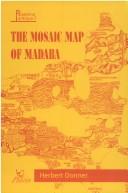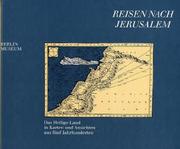| Listing 1 - 5 of 5 |
Sort by
|

ISBN: 9039000115 9789039000113 Year: 1995 Volume: 7 Publisher: Kampen Kok Pharos
Abstract | Keywords | Export | Availability | Bookmark
 Loading...
Loading...Choose an application
- Reference Manager
- EndNote
- RefWorks (Direct export to RefWorks)
Archeology --- Maʻdab⁻a(Jordan) --- Pavements, Mosaic --- Bible --- Geography --- Palestine --- Antiquities --- 913.3 --- Aardrijkskunde van Palestina --- Palestine - Maps --- Maʻdab⁻a(Jordan) - Antiquities
Book
ISBN: 084511705X 9780845117057 Year: 1986 Publisher: New York Liss
Abstract | Keywords | Export | Availability | Bookmark
 Loading...
Loading...Choose an application
- Reference Manager
- EndNote
- RefWorks (Direct export to RefWorks)
Geodesy. Cartography --- anno 1500-1799 --- anno 1800-1899 --- Israel --- Palestine --- Maps --- Bibliography --- 912 <09> <33> --- 912:22 --- Cartografie. Kaarten. Plattegronden. Atlassen--Geschiedenis van ...--Oud-Palestina. Judea --- Kaarten. Atlassen: de bijbel --- -Holy Land --- -Bibliography --- -Maps --- Holy Land --- Bibliography. --- Palestine - Maps - Bibliography
Book
ISBN: 3447018666 9783447018661 Year: 1977 Publisher: Wiesbaden Harrassowitz
Abstract | Keywords | Export | Availability | Bookmark
 Loading...
Loading...Choose an application
- Reference Manager
- EndNote
- RefWorks (Direct export to RefWorks)
Palestine --- Ma'daba (Jordan) --- -Antiquities --- 913.3 --- Aardrijkskunde van Palestina --- -Ma'daba (Jordan) --- -Holy Land --- Maps --- Antiquities --- -Maps --- -Madeba (Jordan) --- Medva (Jordan) --- Holy Land --- Madeba (Jordan) --- Palestine - Maps --- Ma'daba (Jordan) - - Antiquities --- -913.3 --- -Palestine
Book
ISBN: 9782503551043 2503551041 2503551211 Year: 2015 Volume: 18 Publisher: Turnhout Brepols
Abstract | Keywords | Export | Availability | Bookmark
 Loading...
Loading...Choose an application
- Reference Manager
- EndNote
- RefWorks (Direct export to RefWorks)
The special position of Jerusalem among the cities of the world stems from a long history shared by the three Abrahamic religions, and the belief that the city reflected a heavenly counterpart. Because of this unique combination, Jerusalem is generally seen as extending along a vertical axis stretching between past, present, and future. However, through its many ‘earthly’ representations, Jerusalem has an equally important horizontal dimension: it is represented elsewhere in all media, from two-dimensional maps to monumental renderings of the architecture and topography of the city’s loca sancta. In documenting the increasing emphasis on studying the earthly proliferations of the city, the current book witnesses a shift in theoretical and methodological insights since the publication of The Real and Ideal Jerusalem in Jewish, Christian, and Islamic Art in 1998. Its main focus is on European translations of Jerusalem in images, objects, places, and spaces that evoke the city through some physical similarity or by denomination and cult - all visual and material aids to commemoration and worship from afar. The book discusses both well-known and long-neglected examples, the forms of cult they generate and the virtual pilgrimages they serve, and calls attention to their written and visual equivalents and companions. In so doing, it opens a whole new vista onto the summa of representations of Jerusalem.
sacred sites --- churches [buildings] --- Religious architecture --- Jerusalem --- Palestine --- Visual communication. --- Communication in architecture. --- Church architecture --- Sacred space --- Christian art and symbolism --- Symbolic representation. --- History. --- Symbolic representation --- Congresses --- Visual communication --- Communication in architecture --- Kerkelijke architectuur --- Europe --- Cartes --- Early works to 1800 --- Christian pilgrims and pilgrimages --- History --- Jerusalem in Christianity --- Jerusalem in art --- Church architecture - Jerusalem. --- Church architecture - Europe. --- Sacred space - Jerusalem. --- Sacred space - Europe. --- Christian art and symbolism - Jerusalem. --- Christian art and symbolism - Europe. --- Jérusalem --- Saint-Sépulcre (Jérusalem) --- Jerusalem - Symbolic representation. --- Palestine - Maps. --- Jerusalem - History.

ISBN: 3882265752 9783882265750 Year: 1993 Publisher: Wiesbaden: Reichert,
Abstract | Keywords | Export | Availability | Bookmark
 Loading...
Loading...Choose an application
- Reference Manager
- EndNote
- RefWorks (Direct export to RefWorks)
Maps, Early
---
Exhibitions
---
Middle East
---
Palestine
---
Maps
---
912 <017.2>
---
912 <09> <33>
---
910.4 <33>
---
76.047 <569.4 JERUSALEM>
---
094.2 <43 BERLIN>
---
-Maps, Early
---
Geography
---
Cartografie. Kaarten. Plattegronden. Atlassen--Private verzamelingen
---
Cartografie. Kaarten. Plattegronden. Atlassen--Geschiedenis van ...--Oud-Palestina. Judea
---
Reisverhalen: Palestina; Heilig Land
---
Iconografie: landschappen; stadsgezichten; zeegezichten in de prentkunst--Israël--JERUSALEM
---
Oude drukken: bibliotheekcatalogi--
| Listing 1 - 5 of 5 |
Sort by
|

 Search
Search Feedback
Feedback About UniCat
About UniCat  Help
Help News
News